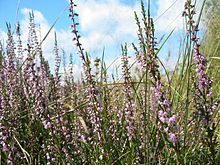Moor heather (biotope type)

Bog heaths are descendent societies, characterized by dwarf shrubs (Chamaephytes) of the heather family (Ericaceae), on acidic, nutrient-poor, (changeable) wet peat soils of partially drained rain bogs (degeneration stages). The distinctive feature of this biotope is the pink appearance at the various flowering times of the heather family. In wetter areas, the most common Subatlantic dominated bell heather ( Erica teralix ), in drier the heather ( Calluna vulgaris ).
Occurrence


Moor heaths are a follow-up company of disturbed rain moor complexes. Their distribution area largely coincides with the distribution of peat moss-rich rain bogs. In Central Europe, moor heaths are particularly widespread in northwest Germany and in the Alpine foothills .
Emergence
Bog heaths are formed by the drying up of rain and sour bogs , mostly through drainage. They are predominantly of anthropogenic origin. Dwarf shrubs and other typical plants of the Bulte ( Bult-Schlenken complex ) are favored even with a slight lowering of the bog's own water level . The temporary access of air to the surface of the peat soils causes the peat to mineralize and the peat body to collapse. Nutrient enrichment and an increase in the pH value of the originally acidic and nutrient-poor peat occur.
Flora and vegetation
The characteristic plant community is the bell heather society (Ericetum tetralicis) within the order of the north-western European heather bogs (Sphagno-Ericetalia). The societies describe drier sections of the raised bogs and represent a transition stage between the raised bog society (Oxycocco-Sphagnetea) and the birch bog forests (Betuletum pubescentis). The dominant plant species include common heather ( Calluna vulgaris ) and bell heather ( Erica tetralix ). , more rarely the black crowberry ( Empetrum nigrum ).
Further characteristic plant species are the German deergrass ( Trichophorum cespitosum subsp. Anglicum ), the soft peat moss ( Sphagnum molle ), Sphagnum compactum , Yellow bog lily ( Narthecium ossifragum ), Sphagnum tenellum , Eriophorum angustifolium ( Eriophorum angustifolium ), vaginal cotton grass ( Eriophorum vaginatum ) , Blue whistle-grass ( Molinia caerulea ), common downy birch ( Betula pubescens ) and silver birch ( Betula pendula ). Constant companions are other heather plants such as bogberry and bilberry ( Vaccinium uliginosum , V. myrtillus ), lingonberry ( Vaccinium vitis-idea ), and more rarely the common cranberry ( Vaccinium oxycoccos ).
Wildlife
Species of heather can take the place of animals typical of raised bogs. When the drought increases, warmth-loving animal species such as adder ( Vipera berus ), forest lizard ( Lacerta vivipara ) and pot-bellied grasshopper ( Omocestus ventralis ) migrate . Moor heaths are also the habitat of a number of species bound to the heather family, such as the heather leaf beetle ( Lochmaea suturalis ), which lives exclusively on the common heather .
Moor heaths are of little importance for the typical life of the raised bogs. Remnants of the original moor flora and fauna can, however, remain in damp depressions. In connection with less degraded raised bog areas, they are important as breeding grounds for the curlew ( Numenius arquata ), golden plover ( Pluvialis apricaria ), wood sandpiper ( Tringa glareola ), black grouse ( Lyrurus tetrix ), short-eared owl ( Asio flammegus ) and meadow harrier ( Circus pygus ).
Hazard and protection
If they are not used, bog heaths are threatened by bushes and forests. Moor heaths are also cultivated as grassland or arable land. Bog heaths can be preserved through decussing and extensive use , provided that the areas can no longer be renatured in the sense of a natural raised bog development. Gentle grazing with heather sheep is now carried out in many places.
literature
- L. Jedicke & E. Jedicke: Color atlas landscapes and biotopes of Germany. Ulmer, Stuttgart, 1992. ISBN 3-8001-3320-2
